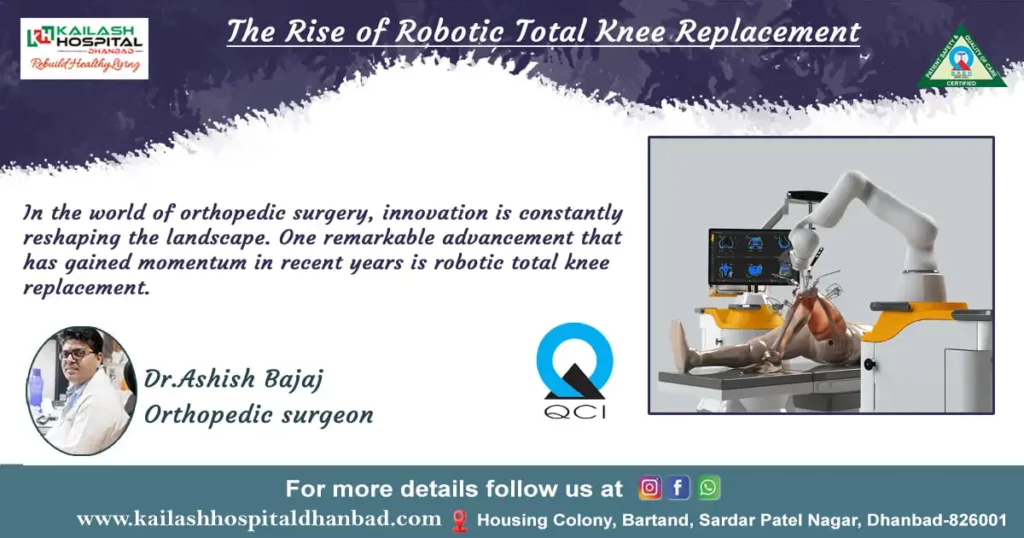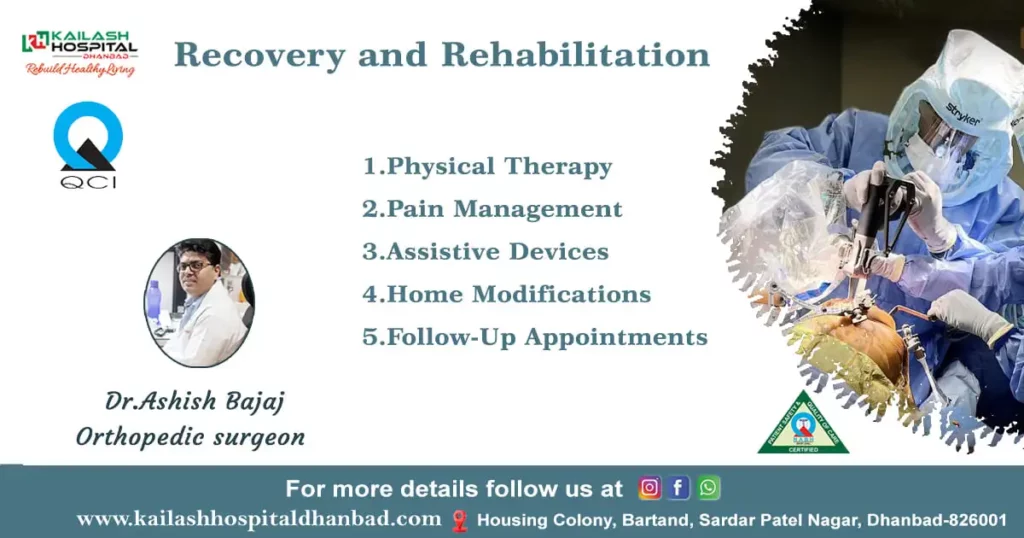
Table of Contents
Robotic total knee replacement
In the world of orthopedic surgery, innovation is constantly reshaping the landscape. One remarkable advancement that has gained momentum in recent years is robotic total knee replacement. As technology continues to intersect with medicine, the integration of robotics into orthopedic procedures offers numerous benefits, promising improved outcomes and enhanced patient experiences. In this blog post, we’ll explore the world of robotic total knee replacement, its advantages, and what patients can expect from this groundbreaking procedure.
The Rise of Robotic Total Knee Replacement:
Robotic-assisted knee replacement surgery is a cutting-edge approach that combines the skills of a highly trained orthopedic surgeon with the precision and guidance of a robotic system. It has quickly gained popularity for its ability to enhance surgical accuracy and patient outcomes.
The Robotic Advantage:
- Enhanced Precision: Robotic systems use advanced imaging technology to create a three-dimensional map of the patient’s knee joint. This map guides the surgeon with pinpoint accuracy during the procedure, ensuring precise implant placement and alignment. The result is a knee joint that functions more naturally, potentially leading to improved longevity of the implant.
- Personalized Planning: Before the surgery, surgeons can create a personalized surgical plan based on the patient’s unique anatomy. This level of customization allows for a tailored approach that optimizes implant positioning and alignment.
- Minimized Tissue Damage: Robotic systems are designed to be minimally invasive. Smaller incisions mean less disruption to the surrounding tissues, reduced pain, and quicker recovery times for patients.
- Real-Time Feedback: During the surgery, the robotic system provides real-time feedback to the surgeon, allowing for adjustments as needed. This dynamic approach ensures that the final result aligns precisely with the preoperative plan.
The Patient Experience:
Preoperative Planning:
Patients undergoing robotic total knee replacement can expect thorough preoperative planning. This includes detailed imaging and a personalized surgical plan developed in collaboration with the surgeon. This planning phase is crucial for ensuring the best possible outcome.
The Day of Surgery:
On the day of surgery, patients receive anesthesia, and the robotic system is used to guide the surgeon throughout the procedure. With its unparalleled precision, the system assists in the removal of damaged tissue and the precise placement of the artificial knee components.
Recovery and Rehabilitation:

Recovery following robotic total knee replacement is often quicker compared to traditional methods. Patients typically experience less pain and can return to their daily activities sooner. However, it’s essential to follow the postoperative rehabilitation plan, including physical therapy, to maximize the benefits of the procedure.
Robotic total knee replacement represents a remarkable leap forward in the field of orthopedic surgery. By combining the skills of skilled surgeons with the precision of robotic systems, patients can expect enhanced outcomes, reduced pain, and quicker recoveries. As this technology continues to evolve, it holds the promise of improving the lives of countless individuals suffering from knee joint issues, reaffirming the role of innovation in healthcare. If you or a loved one are considering knee replacement, discussing the option of robotic-assisted surgery with your orthopedic surgeon may be a significant step toward a pain-free and active future.
Bilateral total knee replacement
Imagine a life where every step is a struggle, where pain is a constant companion, and simple tasks become daunting challenges. This is the reality for many individuals suffering from severe knee arthritis or joint degeneration. However, there is hope in the form of bilateral total knee replacement surgery—a transformative procedure that can offer a new lease on life. In this blog post, we will explore the process, benefits, and recovery journey of bilateral total knee replacement
Understanding Bilateral Total Knee Replacement:
Bilateral total knee replacement, also known as double knee replacement, is a surgical procedure in which both knees are replaced with artificial joint implants. This comprehensive approach is typically reserved for patients who experience debilitating pain and loss of function in both knees due to arthritis, injury, or other medical conditions.
The Procedure:
- Pre-operative Evaluation: The journey begins with a thorough evaluation by your orthopedic surgeon. X-rays, MRI scans, and a comprehensive medical history will help determine the suitability for bilateral total knee replacement.
- Anesthesia: The surgery is performed under general or spinal anesthesia, ensuring you’re pain-free and comfortable throughout the procedure.
- Incisions: Your surgeon will make incisions on both knees to access the affected joints.
- Bone Reshaping: Damaged cartilage and bone are removed from both knee joints.
- Implant Placement: High-quality artificial knee joint components are carefully fitted into the prepared bones.
- Closure: The incisions are closed, and the surgical area is dressed.
Benefits of Bilateral Total Knee Replacement:

- Simultaneous Relief: The most significant advantage is that both knees are addressed at once, providing immediate relief from pain and improved mobility.
- Reduced Hospital Stay: Bilateral total knee replacement often results in a shorter hospital stay compared to having the surgeries separately.
- Faster Recovery: Recovery times can be shorter because the patient undergoes rehabilitation for both knees simultaneously.
- Improved Quality of Life: Many patients experience a significant improvement in their quality of life, allowing them to return to their favorite activities and enjoy life without the constant burden of knee pain.
Recovery and Rehabilitation:
The road to full recovery after bilateral total knee replacement involves physical therapy and lifestyle adjustments:
- Physical Therapy: A customized rehabilitation program is essential to regain strength, flexibility, and joint function.
- Pain Management: Medications are prescribed to manage post-operative pain.
- Assistive Devices: Walking aids, such as crutches or walkers, may be necessary during the initial stages of recovery.
- Home Modifications: Ensure your home is safe and accessible, with handrails and non-slip surfaces in high-risk areas.
- Follow-Up Appointments: Regular follow-up appointments with your orthopedic surgeon are crucial to monitor progress and address any concerns.
Bilateral total knee replacement is a life-changing procedure that offers hope to those who have suffered from chronic knee pain and limited mobility. While it is a major surgery with a rehabilitation process, the benefits often outweigh the challenges. If you or a loved one is considering this procedure, consult with a qualified orthopedic surgeon to determine if bilateral total knee replacement is the right path towards a pain-free and active life. Remember, every step forward is a step towards a brighter, more mobile future.



